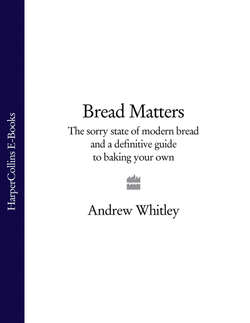Читать книгу Bread Matters: The sorry state of modern bread and a definitive guide to baking your own - Andrew Whitley - Страница 34
What can we do?
ОглавлениеSo it does matter what bread we eat. But how do we get hold of the good stuff? And what is the good stuff?
To ‘get the bread right’, in David Scott’s phrase, requires baking methods using flours with plenty of their original goodness left in and fermentation over periods long enough to make as many nutrients as possible available to the consumer. And the bread must taste great, too.
Clearly the origin of the raw materials comes into it, but the most important questions to ask when choosing bread are:
Has the dough been fermented for long enough?
Have any additives been used?
How much yeast has been used?
Does it contain any added enzymes?
The answers to these questions (if you can get them out of the manufacturer) will largely determine whether the bread is industrial or artisan, made quickly with chemicals or slowly with skill. Unfortunately, appearances can be deceptive and labels opaque, so some detective work may be required. But some simple tests can be applied. For example, if a loaf looks big and airy but tastes insipid and seems curiously unsatisfying, it has probably been engineered more for volume than for integrity; or, if the texture of a loaf does not gradually change as the days pass, if it seems to stay uniformly soft for several days, it has almost certainly got ‘crumb-softening’ enzymes in it.
People are already asking these questions and voting with their feet. If British bread is ever to rise above the status of culinary doormat, we need honesty about ingredients (all of them), clarity about nutrition, and a desire to educate public taste about the relationship between time, flavour and health. To restore trust in bread and reverse its long-term sales decline, the industrial bakers need to clean up their act. Below are some modest suggestions for how to do this, based on the growing body of evidence that the way most modern bread is produced is a nutritional and digestive shambles.
1. All bread additives and enzymes should be labelled in sufficient detail for consumers to be able to tell what they are and where they have come from.
2. No new bakery enzymes should be approved until research establishes whether any of the enzymes currently in use has the same kind of toxic potential as was recently identified in transglutaminase.
3. Much more research should be conducted to compare the digestibility and nutrient availability of fast-made and long-fermented breads.
4. Roller-mills should use all the constituents of the wheat grain in their reconstituted wholemeal flour or should indicate clearly what has been removed and why.
5. Roller-milling procedures should be adapted to produce white and other low extraction-rate flours with at least as high a nutrient profile as stone-milled flours with the same extraction rate.
6. Baseline standards of important micronutrients should be established for wheat (and other cereal) breeding programmes, with the aim of gradually restoring (and in time exceeding) levels found in older varieties. Breeding (and farming) methods should also aim to produce grain with as little of the harmful gliadin protein as possible.
The aim of these measures is simple: to make all bread (white, wholemeal and in between) as good as it can be. If the milling and baking industries adopted them, they would no longer need to hide behind obscure labelling, devious marketing and defensive public relations.
For the consumer not prepared to wait for this happy day, there are two options: seek out an artisan baker or bake your own bread.
A world away from Chorleywood, in villages and industrial estates, farm shops, delis and food halls, selling at farmers’ markets or on the internet, a new breed of artisan bakers is using skill not scale, time not trickery, to reach an increasing number of customers attracted by the openness and integrity of real baking. Here are no additives, enzymes and high-speed doughs – just good ingredients, often organic and local, transformed with patience and effort into loaves full of life.
Although the number of new artisan bakeries has grown significantly in the past ten years, they still account for only a tiny percentage of British bread. But I sense a growing interest in ‘slow’ bread, both from consumers and from the steadily increasing numbers of people who want to learn real baking. Even as the supermarkets’ in-store ‘bakeries’ (many of which simply reheat bread made elsewhere) struggle to retain staff, my ‘Baking for a Living’ courses are over-subscribed, often by people drawn to bread and fermentation from comfortable but unfulfilling professional careers. Home bakers, whether they use traditional methods or bread machines, like to decide for themselves what goes into their bread and how it is made. If you are one of them, or would like to be, what follows will tell you all you need to know to do it well.
